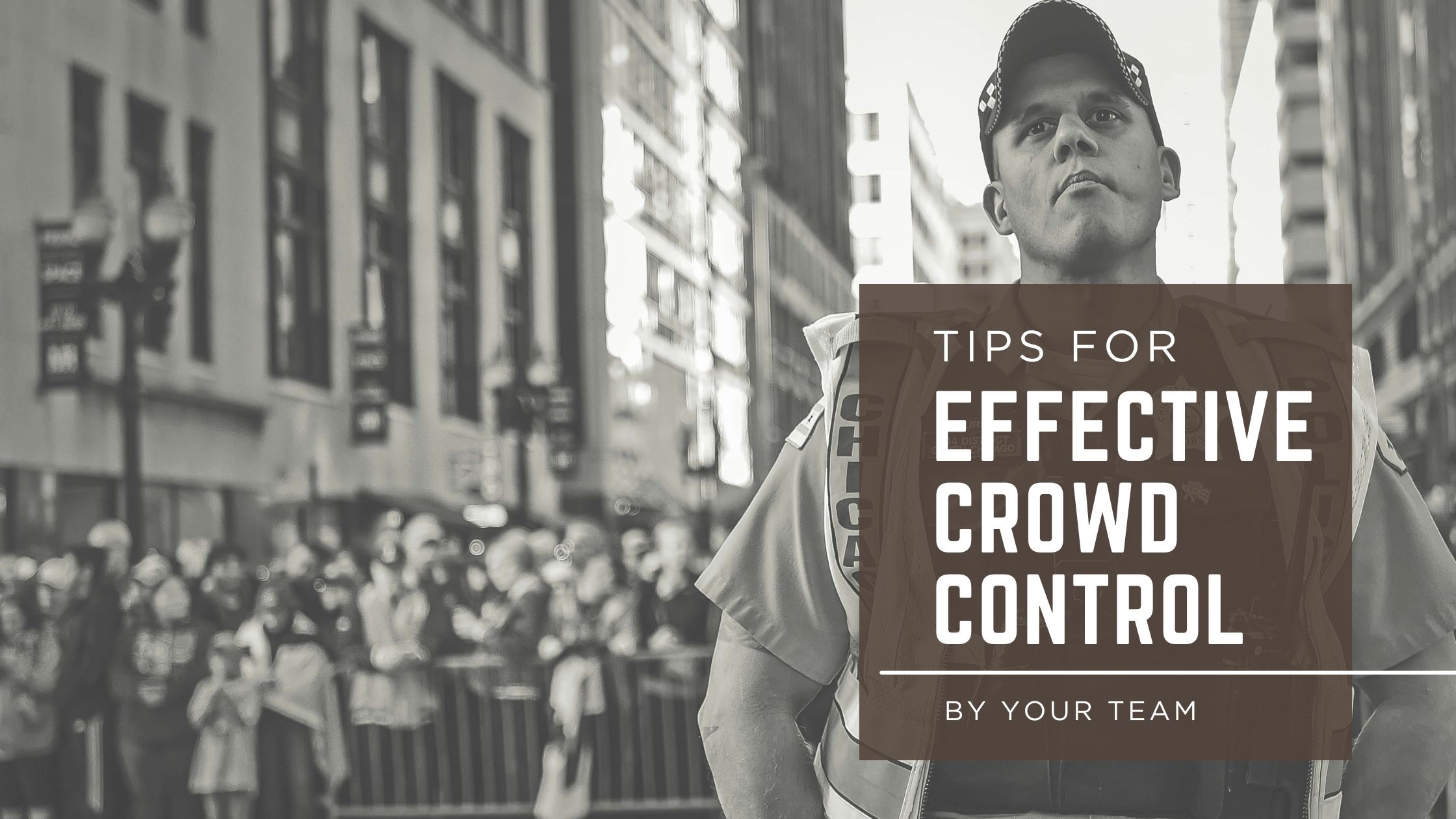How to Train Staff for Effective Crowd Control
Effective crowd control is a critical skill in many industries, from large events and concerts to retail and hospitality. The ability to manage and guide a crowd can make the difference between a smooth, enjoyable experience and a potentially dangerous or chaotic situation. Training your staff to handle crowd dynamics effectively ensures not only the safety and security of everyone involved but also enhances the overall atmosphere. In this blog, we’ll explore practical strategies and techniques for training staff to excel at crowd control, helping you create a safe environment where both customers and employees feel confident and secure.
Essential Training Tips for Ensuring Effective Crowd Control by Your Team
Managing crowds is an essential part of organizing successful events. Whether you’re overseeing a packed sports event, a music festival, or any large-scale gathering, ensuring effective crowd management is crucial for public safety, smooth flow, and a positive experience for attendees. Crowd control can be a complex challenge, especially when dealing with high-traffic areas, unpredictable crowd behavior, and potential risks. However, with the right training, strategies, and tools, your team can handle tense situations and ensure crowd safety while maintaining a positive atmosphere.
Step-by-Step Guide to Training Your Team for Safe and Efficient Crowd Management
Here are the key steps for training your team in safe and efficient crowd management:
1. Understanding the Role in Crowd Management
The first step in effective crowd management is ensuring that every member of your team understands their specific role in the crowd management plan. This involves recognizing the critical aspects of crowd control, such as managing crowd behavior, monitoring crowd size, and addressing any potential threats. Whether it’s a security guard, ground personnel, medical staff, or event planner, every individual must know their responsibilities and how they contribute to the overall safety of the event. A clear understanding of roles helps with quick identification of potential risks and ensures that the necessary crowd control measures are implemented in real-time.
2. Developing Communication Protocols
Effective communication is at the heart of successful crowd control. It’s vital to establish clear communication channels between event staff, security teams, medical personnel, and law enforcement. Equip your team with reliable communication devices and ensure that everyone knows how to use them properly. This will facilitate seamless communication during the event, especially in tense situations where quick decisions are necessary.
Training your staff to utilize mobile apps, digital displays, and SMS alerts can provide real-time updates, allowing for continuous monitoring of crowd movements. For example, if a crowd surge occurs, event staff can send out notifications to specific team members, enabling them to respond quickly and effectively. Effective communication strategies ensure that the right people are alerted to emergency procedures, evacuation routes, and medical situations.
3. Crowd Control Strategies and Techniques
Crowd management strategies are the backbone of any event’s success. Training your team in proper crowd control techniques is essential. These strategies involve the use of crowd control stanchions, physical barriers, and effective crowd management tools to guide the flow of attendees. By planning the layout of your event venue and using crowd control measures such as retractable safety barriers and exit lanes, you can ensure smooth movement and reduce the risk of crowd surges.
Additionally, understanding the basics of crowd psychology can help your team anticipate and manage potential issues before they arise. Your staff should be trained to recognize signs of distress or unruly crowd behavior early on and respond with proactive measures. The goal is to maintain the smooth flow of traffic while preventing any dangerous situations or accidents.
If you would like to learn more about crowd control, visit our blog: The Dos and Don’ts of Crowd Control.
4. Medical Emergencies and Emergency Services
A key aspect of crowd management is having a plan in place for medical emergencies. Medical personnel should be trained to identify and respond to medical situations, such as heatstroke, dehydration, or injuries. In addition, ground personnel should know how to quickly identify signs of distress and coordinate with medical staff for a timely response.
It’s also crucial to coordinate with emergency services, such as law enforcement, to address any unexpected situations and incidents at events that may arise. For instance, in the event of a medical emergency or evacuation, quick access to emergency exits and emergency routes is vital. Ensure your team is familiar with emergency protocols and evacuation routes to ensure a smooth evacuation process in case of emergencies. This preparedness reduces panic and keeps everyone safe in case of a medical emergency or any other unforeseen event.
5. Real-Time Monitoring and Adaptation
Effective crowd management is an ongoing process that requires continuous monitoring and adaptation. The event environment can change rapidly due to factors like weather conditions, crowd size, or unexpected incidents. Utilize real-time monitoring systems and digital signage to keep everyone informed and updated.
AI-powered crowd analytics can provide valuable insights into crowd movements and behaviors, helping you identify potential threats early. Additionally, integrating tools for crowd control with mobile apps allows your team to receive instant notifications and real-time information, keeping them alert and prepared for any crowd surges or dangerous situations. These systems help provide real-time updates, so your team can make quick, informed decisions.
6. Emergency Procedures and Legal Liabilities
Having well-thought-out plans and emergency procedures is essential for the safety of attendees. Every staff member should be trained to recognize emergency situations, such as security threats, medical emergencies, or signs of crowd panic. They should also be familiar with emergency response plans, including emergency exits, evacuation routes, and the proper procedures for communicating with emergency services.
Moreover, ensuring your team is well-versed in emergency protocols helps minimize legal liabilities and potential legal consequences. Event organizers must ensure that their event complies with safety regulations and provides adequate training to all personnel. An effective plan in place helps to reduce the risk of legal repercussions, ensuring your team can act quickly and appropriately in case of an incident.
7. Continual Training and Feedback
Crowd control is a dynamic skill that requires effective planning and continual training. Following each event, review the effectiveness of your crowd management efforts with your team. What strategies worked well? Where could improvements be made? This feedback loop allows your team to adjust and refine their crowd management practices for future events. Providing additional training, especially for handling medical emergencies or adapting to adverse weather conditions, will help your team stay prepared for any situation.
Skilled personnel, along with a proactive approach, are vital for ensuring the effectiveness of crowd control. Event planners should invest in proper training for all team members, ensuring they are equipped with the knowledge and skills to manage large crowds safely and efficiently.
8. Providing a Positive Attendee Experience
The ultimate goal of crowd control efforts is not just safety but also providing a positive experience for attendees. A well-organized event where the flow of traffic is smooth, and attendees feel safe fosters a positive atmosphere. With meticulous planning, proactive measures, and the right tools, your team can ensure that attendees enjoy a hassle-free and safe event. Remember, the success of your crowd control strategies directly impacts the attendee event experience.
Final Thoughts
By investing time and resources in training your staff, developing effective crowd management plans, and utilizing the latest crowd control strategies, barrier systems, and tools, you’ll be well-prepared for any future events. With proper training, your team can handle any crowd behavior, whether it’s a crowd surge or a medical situation, ensuring that your events remain safe, enjoyable, and memorable for all involved.


